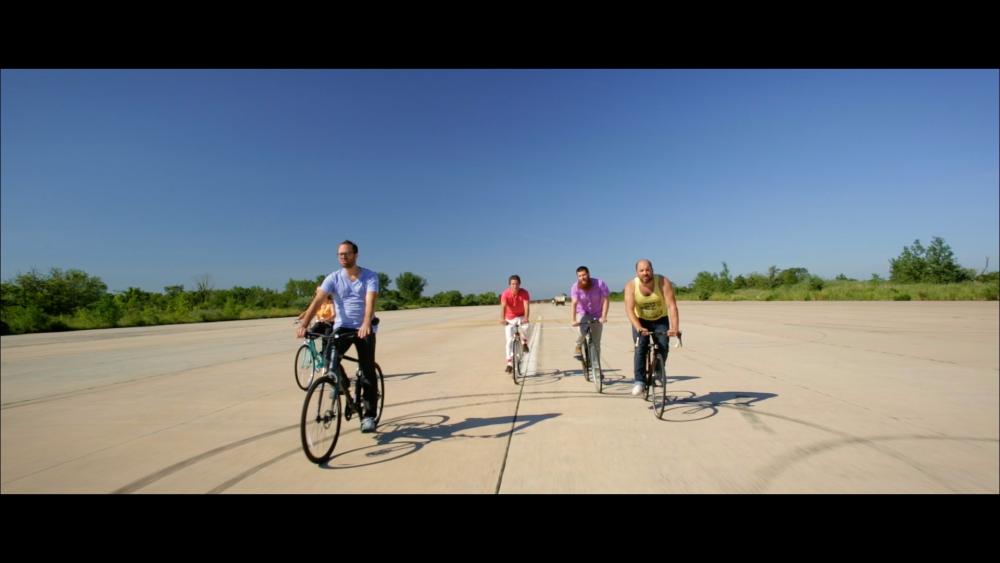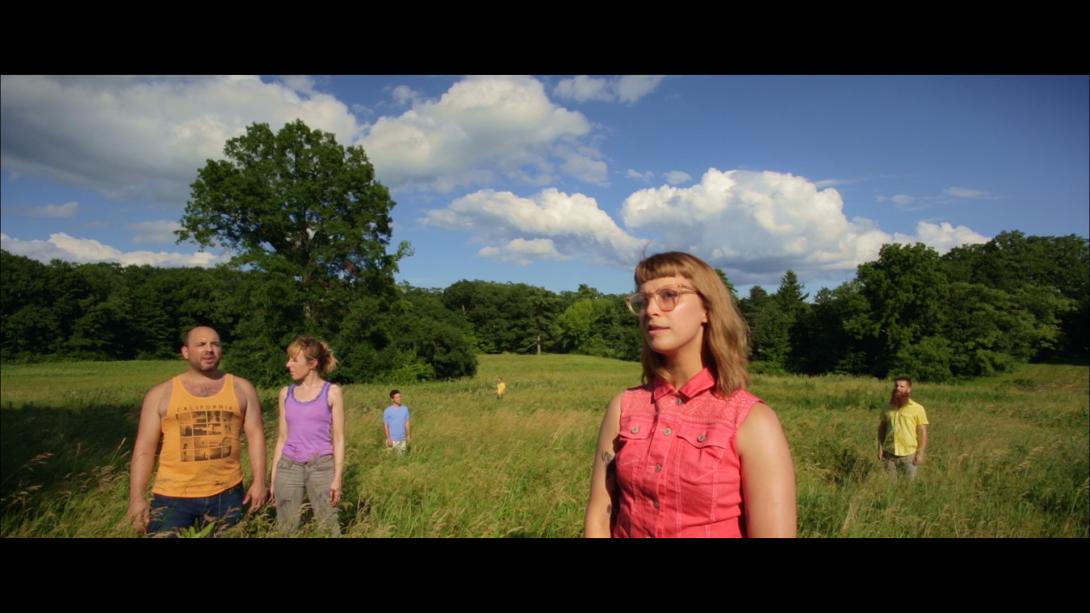Previously on Nature Theater of Oklahoma
by Florians Malzacher
Since 2004, under the name of Nature Theater of Oklahoma, Kelly Copper and Pavol Liska have created some of the most notable theater pieces to emerge in recent years. Their pieces are unmistakable in their mixture of conceptual precision, an idiosyncratic use of modernist artistic strategies (often closer to visual than performing arts), and at the same time performances full of passion – without fear of seemingly trashy superficiality, and freely borrowing from every possible theater tradition. – Florian Malzacher
Both Copper’s and Liška’s fascination with audio recording began early. As a child and throughout her youth during the seventies and early eighties, Kelly Copper moved around the USA with her family nearly every six months. This did not leave much time for lasting friendships; however, it allowed for even more time with books and the cassette recorder that was one of her first toys. Her father, a radio host, worked with all manner of sound instruments every day. Kelly and her sister listened to him from home and would produce their own radio plays full of homemade special effects they created using everything that was available to them, even the sound of a flushing toilet.
Pavol Liška’s interest in the theater began when he was sixteen during and after the “velvet revolution” when in Czechoslovakia people from the theater changed the political world with the playwright Václav Havel becoming president and actors and
directors becoming ministers and ambassadors. Liška, who grew up in a small town, had never been to the theater at this point. Even then he did not experience the theater live, but rather through audio cassettes. Pieces from Havel, Kohout, and others circulated via copies of live recordings. “I thought that theater was always presented in this way and for me it was enough.” And so it was no problem for him that his first self-composed theater piece (which strongly resembles the work of Havel) could only be realized in the form of an audio cassette recording. He had no idea about the stage; it did not interest him. “All I wanted was to hold a cassette in my hands.”
The idea of generating an entire work solely from oral reports and conversations was the origin of No Dice (2007). Copper and Liška drew the material for the three-and-a-half-hour performance work, from roughly one hundred hours of telephone conversations about art, and life. The recordings were cut together and placed in new contexts in order to generate new meanings. Telephone conversations have a noticeably different flow than live conversations. Because one’s conversation partner is not visible, confirmations must constantly be requested and given. The absence of facial expressions results in nuances becoming exaggerated and the lack of gesturing requires one to articulate more clearly what it is one wishes to say. Little things are enlarged and create a sudden and irritating artificiality by being transferred onto the stage. To retain the original flow of the speech, texts are not transcribed and then memorized by the actors, but rather in No Dice played directly through headphones on synchronized iPods. The performers simultaneously speak the lines that they hear through the headphones. Even when they fill the texts with different meanings or alter them with strong (for example French) accents, the rhythm and intonation remain intact. Thus arises an idiosyncratic form of script as well as an unmistakable manner of speaking, a variation on the aesthetics of naturalism á la Gerhard Hauptmann: at the same time highly authentic and artificial.
For Life and Times the use of recorded telephone conversations as the basis for a script was further radicalized. The ten phone calls in which Kristin Worrall, a musician and performer in No Dice, detailed her life story lasted sixteen hours in total. The life of this not at all untypical thirty-four-year-old American, is above all interesting because it reminds us in so many ways of our own. Word for word and without corrections, this telephone conversation was transcribed and made into the libretto of Life and Times, with every pause, slip of the tongue, stutter, and mistake of the original.
The use of stories told by others is a part of Copper’s and Liška’s concept of working with “found” material. They explicitly align themselves in the art-historical tradition founded by Marcel Duchamp’s found, and redefined as art, readymades—from experimental found footage films in the sixties up to present-day documentary theater forms. The recycling and processing of found material became significant for Copper and Liška at the end of the nineties, when they turned their backs on the theater for four years and focused their efforts exclusively on visual arts. Old family super-8 films from the flea market and photos found in the garbage interested them more than large-scale, original artistic endeavors. “As an artist there was little that you could do that would have been more beautiful than these films and photos.” When they returned to theater in 2002, they brought these ideas, based primarily in visual art, into the theater not only regarding the generation of scripts but also regarding material related to movement, costumes, and expressions.
In some respects, too, the English language is an objet trouvé for Pavol Liška. He learned it with remarkable speed and thoroughness upon arriving in the USA at the age of eighteen because he had to enroll at the university immediately in order to obtain a student visa. His ability to express himself may have exceeded that of the majority of native-born Americans, but like many other immigrant authors who work in a language other than their own, he observes things with a certain distance and fascination. Just as found material is presented in a different context, so too is the English language itself.
It is this framing gaze that reveals what is epic about the everyday life stories in No Dice and Life and Times, as well in the Brechtian sense of the gestural, as in the indulging and playful theatrical continuation of the epic traditions from the Greek tragedies to the Middle-Age heroic epics and folktales. The “epic” is denoted by its narrative approach, through directly addressing the audience (far from any thought of a fourth wall), through its tediously extensive accounts of individual conditions and landscapes, and through a certain propensity for dwelling.
Nature Theater desires to be excessive and colossal: “we are so arduously entertaining that it becomes painful.” The “epic” only rarely highlights the dramatic, emphasizes conflict, or changes in tempo. It is a river of description that occasionally branches out but always finds its way back to its main current, a large story that is made up of many small ones. It is precisely in this tense relationship between free-flowing speech (for example in tales passed down through word of mouth) and regulated speech (as in Greek or Middle Age heroic epics) that Life and Times is played out. The banal, the casual, and the everyday are exaggerated and the instructions for the actors are “always look for the maximum degree of meaning.” Look for what is stuck deep beneath the surface. As a result, every filler and every “anyway” becomes a notion. As in all epics, even the blandest of stories become allegorical and collective: it is always also about us. Dice, Coins, and the Rules of the Game Quasi-random decisions, tasks, and rules of the game are the backbone of the structure in which Kelly Copper and Pavol Liška think. That they are at the same time obviously control freaks only appears to conflict with the role they assign to chance and the unknown in their work. Clearly influenced by the compositional and choreographic principles of chance operation in the oeuvre of John Cage and Merce Cunningham, there is no work by Nature Theater that was not written in large part by dice, decks of cards, and coins. However, they are anything but laissez faire in their productions; the large proportion of quasi-random decisions compels them to continuously affirm and question their own sense of control. Just like Cage, they often understand chance to be superior to their own preferences, especially, as Cage described it, because chance is not something completely arbitrary. Rather it is something that comes to you and then, in a sense, belongs to you. Something that one must view as a challenge and which demands flexibility of thought. Leaving certain decisions to chance does not equal less work; it merely shifts the focus.
Chance and freedom as artistic practices are only interesting within the scope of clearly defined rules. Anything goes does not produce much in way of aesthetics. The constraints and hurdles that Copper and Liška employ in their theater pieces have an especially important meaning. They achieve a balance between the freedoms for the performers and control for the directors, between the unpredictable and the particular. They do not believe that something that is too easy can truly have value in life as well as in theater. They want to see actors work, especially if the point is to be entertaining. They are not interested in apparently effortless virtuosity. This would be a sign for them that one obviously is not challenging oneself enough and has not yet reached one’s limits. Magic tricks are only interesting when one realizes that it is not really magic.
In Life and Times the constraints and hurdles facing the actors as well as the directors are manifold. The speech of the telephone monologue is itself restrictive, has its own rules, and resists being put into the theatrical frames Copper and Liška invent for it. No filler removed, no rhythm smoothed out, the signifying elements stay in conflict, they don’t agree on a common syntax. And the performers are always in the midst of this struggle—often even stripped of the weapons and tricks they can handle best.
By the end of Episode 4, Life and Times had migrated completely into a different genre: an animated film (which later was removed and became Episode 4.5). It was the plan to continue with the animation and even create a full-length film with Episode 5, but the physical challenge (of the drawing) was just too much. The additional challenge the material of Episode 5 presented was the result of a technical failure: only about 20 minutes of the original recordings was left, not enough for a full-length performance. Together with Episode 6, which also only exists as a fragment, the “lost years,” as they are already known, call for their own medium. Episode 6 will take the form of an audio installation, and Episode 5 has become a book.
The evenings with Nature Theater, whether in the form of theater, musical, film, audio installation or book, are always a puzzle picture for the audience. Depending on where we choose to focus, we may find ourselves stuck on the surface or fixated on the story behind it. Form and content are in a state of constant conflict. Lines, acting techniques, melodies, space, and costumes do not duplicate any meaning and do not refer to one obvious interpretation that the director has determined to be interesting. They are offerings, they create associations and definitional contexts and it is up to us to develop our own senses. It is true for us, too: if it is too easy, we have not yet arrived at where we could be.
The first four episodes of Life and Times were all performed at the Kaaitheater. Episode 5 became a book, of which this text is an abridged part. Florian Malzacher has collaborated with Nature Theater of Oklahoma as dramaturge.

